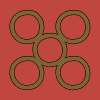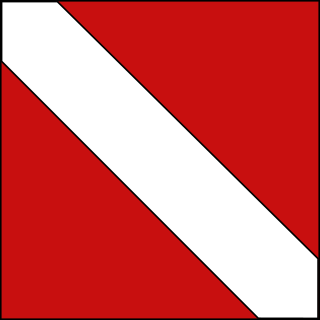
The 32nd Division was an infantry division of the British Army that was raised in 1914, during the First World War. The division was raised from volunteers for Lord Kitchener's New Armies, made up of infantry 'Pals battalions' and artillery brigades raised by public subscription or private patronage. The division was taken over by the War Office in September 1915. It served in France and Belgium in the trenches of the Western Front for the duration of the war. It saw action at the Battle of the Somme, the Pursuit to the Hindenburg Line, the Defence of Nieuport, the German spring offensive, and the Allied Hundred Days Offensive beginning at the Battle of Amiens. After the Armistice it marched into Germany as part of the Army of Occupation.
The 14th Infantry Brigade was a British Army formation during the Second Boer War, World War I, when it served on the Western Front, and World War II, when it fought in Crete and Tobruk, and then as Chindits in Burma.
61st Brigade was an infantry formation of the British Army during the First World War. It was formed in September 1914 as part of the new army also known as Kitchener's Army and was assigned to the 20th (Light) Division, serving in the trenches of the Western Front. It was reformed as a motorised infantry brigade in Italy during the Second World War.
The 19th Brigade is an Army Reserve formation of the British Army. As the 19th Infantry Brigade, it fought in the First and Second World War.

42nd Brigade was an infantry formation of the British Army during both World Wars. It was formed in August 1914 as part of Kitchener's Army, and was assigned to the 14th (Light) Division, serving on the Western Front. It was reformed in World War II for line of communication and deception purposes. As 42 Brigade it became a regional headquarters from 1982 to 2017.
43rd Brigade was an infantry formation of the British Army during both World Wars. It was formed in August 1914 as part of Kitchener's Army and was assigned to the 14th (Light) Division, serving on the Western Front. It was reformed in 1943 as an internal security formation for North Africa and was later employed for deception purposes in Sicily. As 43 (Wessex) Brigade it was a regional headquarters in the UK from 1985 to 2014.

The 7th (Meerut) Division was an infantry division of the Indian Army and before 1895, the Bengal Army, that saw active service during World War I.
The Durham Light Infantry Brigade was formed in 1902 to command the part-time Volunteer battalions of the Durham Light Infantry (DLI). Previously these had been in a combined Tyne and Tees Brigade with battalions of the Northumberland Fusiliers. It consisted of the 1st–4th Volunteer Battalions of the DLI, which were renumbered as the 5th–8th Battalions when the Volunteers were subsumed into the Territorial Force (TF) under the Haldane Reforms of 1908. Consisting of 6th–9th Battalions, it became part of the TF's Northumbrian Division. During World War I it was numbered as the 151st Brigade on 14 May 1915, when the division became the 50th (Northumbrian) Division. The TF also raised 2nd Line units and formations, and the 190th Brigade was formed in 63rd Division. The 1st Line battalions adopted the prefix '1/'

The 140th Brigade was an infantry brigade formation of the British Army's Territorial Army (TA) that had its origins in a South London Brigade of the former Volunteer Force. It served on the Western Front in the First World War and was recreated during the Second World War where it served only in the United Kingdom as a training formation.

The 141st Brigade was an infantry brigade of the Territorial Army, part of the British Army, that served in the First World War and remained in the United Kingdom throughout the Second World War.
The 142nd Brigade was an infantry brigade of the Territorial Army, part of the British Army, that served in the First and the Second World Wars, and remained in the United Kingdom throughout the latter.
59th Brigade was an infantry formation of the British Army during World War I. It was formed in September 1914 as part of the new army also known as Kitchener's Army and was assigned to the 20th (Light) Division, serving on the Western Front. It was popularly known as the 'Greenjacket Brigade' because it was composed of battalions of the King's Royal Rifle Corps and the Rifle Brigade, whose full dress uniforms were Rifle green.
60th Brigade was an infantry formation of the British Army during World War I. It was formed in September 1914 as part of the new army also known as Kitchener's Army and was assigned to the 20th (Light) Division, serving on the Western Front.
The 91st Brigade was an infantry formation of the British Army during World War I. It was raised as part of 'Kitchener's Army' and was assigned to the 30th Division. After the original formation was converted into a reserve brigade, the number was transferred to a brigade of 'Manchester Pals'. The brigade landed in France at the end of 1915 and was transferred to the Regular 7th Division. It saw action at the Somme, Arras, and Ypres before being sent to the Italian Front, where it took part in the final Battle of Vittorio Veneto. The brigade's number was briefly revived during the 1950s.
The 214th Brigade was an infantry formation of the British Army during World War I. It was raised as a second line brigade of the Territorial Force and initially assigned to the 71st Division for coast defence. Later it was reorganised as an all-arms brigade group for service in North Russia, but this was cancelled and it was reassigned to the 67th Division, a training and home defence formation, until the end of the war.
The 206th Brigade was a formation of the British Army during World War I. It was raised as a 2nd-Line duplicate of the Essex Brigade of the Territorial Force and formed part of the 69th Division. It served as a training formation in the United Kingdom without going overseas.
The 116th Brigade was an infantry formation of the British Army during World War I. Originally raised in December 1914 from locally raised volunteer units of 'Kitchener's Army' known as 'Pals battalions', it was later redesignated and the number was transferred to a different 'Pals' brigade. It fought with 39th Division on the Somme and the Ancre, at Ypres and in the German spring offensive. After the appalling casualties in that campaign it was relegated to a training organisation preparing US Army units for active service. It was disbanded in 1919.
The 117th Brigade was an infantry formation of the British Army during World War I. Originally raised in December 1914 from locally-raised volunteer units of 'Kitchener's Army' known as 'Pals battalions', it was later redesignated and the number was transferred to a new 'Pals' brigade formed in July 1915. It fought with 39th Division on the Somme and the Ancre, at Ypres and in the German spring offensive. After the appalling casualties in that campaign it was relegated to a training organisation preparing US Army units for active service. It was disbanded shortly after the Armistice with Germany, but the number was transferred to another formation brought under 39th Division. It was disbanded in 1919.
The 118th Brigade was an infantry formation of the British Army during World War I. Originally raised in December 1914 as part of 'Kitchener's Army' it was later redesignated and the number was transferred to a new brigade formed in July 1915. This initially commanded 'Pals battalions' under training; later it took over experienced Territorial Force battalions that were already serving on the Western Front. It fought with 39th Division on the Somme and the Ancre, at Ypres and in the German spring offensive. After the appalling casualties in that campaign it was relegated to a training organisation preparing US Army units for active service. It was disbanded shortly after the Armistice with Germany.

The 123rd Brigade was an infantry formation of the British Army during World War I. It was raised as part of the New Armies. After the original 123rd Bde was renumbered, a new brigade was formed and served with the 41st Division from 1916 to 1919 on the Western Front, in Italy, and with the British Army of Occupation in Germany.




